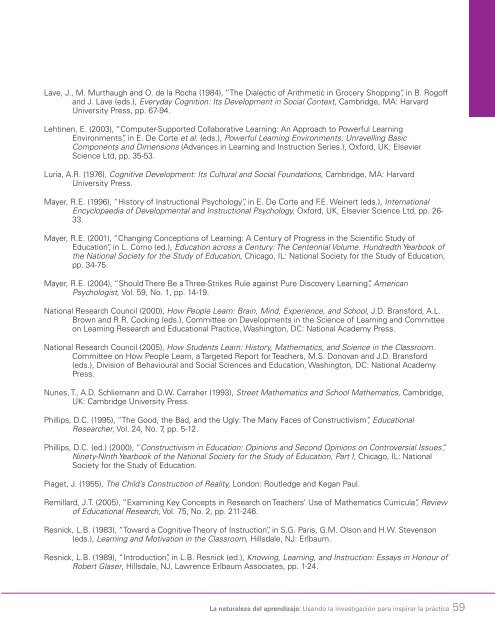del aprendizaje
s0eH3032Q2U
s0eH3032Q2U
You also want an ePaper? Increase the reach of your titles
YUMPU automatically turns print PDFs into web optimized ePapers that Google loves.
Lave, J., M. Murthaugh and O. de la Rocha (1984), “The Dialectic of Arithmetic in Grocery Shopping”, in B. Rogoff<br />
and J. Lave (eds.), Everyday Cognition: Its Development in Social Context, Cambridge, MA: Harvard<br />
University Press, pp. 67-94.<br />
Lehtinen, E. (2003), “Computer-Supported Collaborative Learning: An Approach to Powerful Learning<br />
Environments”, in E. De Corte et al. (eds.), Powerful Learning Environments: Unravelling Basic<br />
Components and Dimensions (Advances in Learning and Instruction Series.), Oxford, UK: Elsevier<br />
Science Ltd, pp. 35-53.<br />
Luria, A.R. (1976), Cognitive Development: Its Cultural and Social Foundations, Cambridge, MA: Harvard<br />
University Press.<br />
Mayer, R.E. (1996), “History of Instructional Psychology”, in E. De Corte and F.E. Weinert (eds.), International<br />
Encyclopaedia of Developmental and Instructional Psychology, Oxford, UK, Elsevier Science Ltd, pp. 26-<br />
33.<br />
Mayer, R.E. (2001), “Changing Conceptions of Learning: A Century of Progress in the Scientific Study of<br />
Education”, in L. Corno (ed.), Education across a Century: The Centennial Volume. Hundredth Yearbook of<br />
the National Society for the Study of Education, Chicago, IL: National Society for the Study of Education,<br />
pp. 34-75.<br />
Mayer, R.E. (2004), “Should There Be a Three-Strikes Rule against Pure Discovery Learning”, American<br />
Psychologist, Vol. 59, No. 1, pp. 14-19.<br />
National Research Council (2000), How People Learn: Brain, Mind, Experience, and School, J.D. Bransford, A.L.<br />
Brown and R.R. Cocking (eds.), Committee on Developments in the Science of Learning and Committee<br />
on Learning Research and Educational Practice, Washington, DC: National Academy Press.<br />
National Research Council (2005), How Students Learn: History, Mathematics, and Science in the Classroom.<br />
Committee on How People Learn, a Targeted Report for Teachers, M.S. Donovan and J.D. Bransford<br />
(eds.), Division of Behavioural and Social Sciences and Education, Washington, DC: National Academy<br />
Press.<br />
Nunes, T., A.D. Schliemann and D.W. Carraher (1993), Street Mathematics and School Mathematics, Cambridge,<br />
UK: Cambridge University Press.<br />
Phillips, D.C. (1995), “The Good, the Bad, and the Ugly: The Many Faces of Constructivism”, Educational<br />
Researcher, Vol. 24, No. 7, pp. 5-12.<br />
Phillips, D.C. (ed.) (2000), “Constructivism in Education: Opinions and Second Opinions on Controversial Issues”,<br />
Ninety-Ninth Yearbook of the National Society for the Study of Education, Part I, Chicago, IL: National<br />
Society for the Study of Education.<br />
Piaget, J. (1955), The Child’s Construction of Reality, London: Routledge and Kegan Paul.<br />
Remillard, J.T. (2005), “Examining Key Concepts in Research on Teachers’ Use of Mathematics Curricula”, Review<br />
of Educational Research, Vol. 75, No. 2, pp. 211-246.<br />
Resnick, L.B. (1983), “Toward a Cognitive Theory of Instruction”, in S.G. Paris, G.M. Olson and H.W. Stevenson<br />
(eds.), Learning and Motivation in the Classroom, Hillsdale, NJ: Erlbaum.<br />
Resnick, L.B. (1989), “Introduction”, in L.B. Resnick (ed.), Knowing, Learning, and Instruction: Essays in Honour of<br />
Robert Glaser, Hillsdale, NJ, Lawrence Erlbaum Associates, pp. 1-24.<br />
La naturaleza <strong>del</strong> <strong>aprendizaje</strong>: Usando la investigación para inspirar la práctica 59


